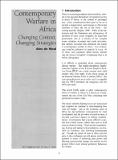| dc.contributor.author | Waal, Alex de | en |
| dc.date.accessioned | 2016-02-24T15:54:43Z | |
| dc.date.available | 2016-02-24T15:54:43Z | |
| dc.date.issued | 01/07/1996 | en |
| dc.identifier.citation | Waal, A., d. (1996) Contemporary Warfare in Africa: . IDS Bulletin 27(3): 6-16 | en |
| dc.identifier.issn | 1759-5436 | en |
| dc.identifier.uri | https://opendocs.ids.ac.uk/opendocs/handle/20.500.12413/9235 | |
| dc.description.abstract | Summaries This article attempts to synthesize a coherent analysis of the ways in which warfare in Africa has changed since the end of the Cold War. Strategies used by governments to combat insurgencies and counter the threat of military coups d'etat are assessed, contrasting the centralized military machine of the former Ethiopian government with the policy of fragmenting military authority pursued by President Mobutu of Zaire. The economic decline of African governments and the decline of external patronage of both governments and rebel movements has led to important structural changes that compel military structures to seek to extract resources from local populations, humanitarian aid programmes, and control of commerce. This leads to much more decentralized, locally?specific forms of military organization. The article finally deals with innovations in military doctrine in Africa, specifically the way in which counter?insurgency and destabilization strategies have been adapted and developed, and the use of children as combat troops. | en |
| dc.format.extent | 11 | en |
| dc.publisher | Institute of Development Studies | en |
| dc.relation.ispartofseries | IDS Bulletin Vol. 27 Nos. 3 | en |
| dc.rights.uri | http://www.ids.ac.uk/files/dmfile/IDSOpenDocsStandardTermsOfUse.pdf | en |
| dc.title | Contemporary Warfare in Africa: | en |
| dc.type | Article | en |
| dc.rights.holder | © 1996 Institue of Development Studies | en |
| dc.identifier.doi | 10.1111/j.1759-5436.1996.mp27003002.x | en |

